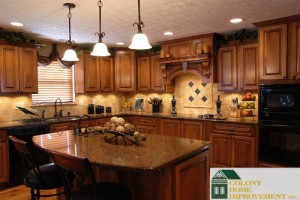Designing an Eco-Friendly and Energy-Efficient Kitchen
One of the most popular trends when it comes to kitchen remodeling is being eco-friendly and efficient. Creating a green kitchen offers many advantages, including eliminating waste, conserving natural resources, reducing landfill waste and helping you save money. There is no single design choice when it comes to making your kitchen eco-friendly; it’s all about your personal style and taste. Here are some tips for choosing materials, features, fixtures and other kitchen additions that best fit your kitchen remodeling plans.
Countertops
Your kitchen remodeling plans should include sturdy, easy-to-clean countertops. Green and eco-friendly options include IceStone, a combination of concrete and recycled quartz that comes in a variety of colors. You can also use quartz, hemp, recycled paper or other all-natural materials.
Stainless steel is another eco-friendly option for your countertops. It requires little maintenance, is ideal for cooking and lasts for years, making it a durable choice.
Lighting
Reduce your electric bill by adding more windows to your kitchen. This will fill the space with plenty of natural light, while conserving resources. Ensuring your new windows provide adequate ventilation will give your kitchen an improved indoor air quality.
When planning a kitchen remodeling project, you may want to consider investing in high performance replacement windows. This could help you save money on your heating bills by providing increased insulation. These windows can also make your kitchen feel warmer and more inviting, especially on those cold winter mornings.
Cooktops and Ovens
Consider an electric-induction cooktop for your kitchen upgrade. This kind of stovetop helps heat your food quickly and evenly by transferring the electronic magnetic energy right onto your pans. While shopping for appliances, keep in mind purchasing an oven with the Energy Star label will help you save as much as 80 percent on your energy bills.
Refrigerators
Refrigerators are the second largest energy consumers in a household. If your kitchen additions include a new refrigerator, look for one with an Energy Star label. According to Energy Star, most refrigerators with the label use 10 to 50 percent less energy than regular models. Another tip for conserving energy with your refrigerator is to avoid anything larger than what you truly need.
Flooring
Though perhaps not the first upgrade you think of when it comes to the kitchen, flooring is an important part of kitchen remodeling. You want to choose materials that are safe for the environment and cohesive with the style of the home.
A good choice for eco-friendly flooring is linoleum made from all-natural materials. Wood flooring, or flooring from a renewable resource, such as bamboo, is another green flooring option. Cork and concrete floor tiles are great sources as well because both use natural pigments.
Sinks and Faucets
When upgrading fixtures in your kitchen, consider a sink that uses recycled material, such as stainless steel or copper. Browse salvage yards for used material, which can help you save money on kitchen remodeling plans.
Look for a faucet with an aerator, which will inject oxygen into the water stream. This helps produce less water than traditional faucets, decreasing wasteful overuse and saving you money on your water bills at the same time.
If you are looking for a Massachusetts home improvement contractor for a kitchen remodel or other project, contact us. Our experienced team can help you transform your vision into reality.














